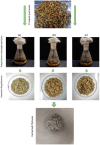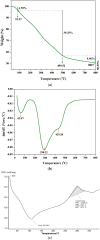Extraction of Fungal Chitosan by Leveraging Pineapple Peel Substrate for Sustainable Biopolymer Production
- PMID: 39274088
- PMCID: PMC11397891
- DOI: 10.3390/polym16172455
Extraction of Fungal Chitosan by Leveraging Pineapple Peel Substrate for Sustainable Biopolymer Production
Abstract
The cost-effective production of commercially important biopolymers, such as chitosan, has gained momentum in recent decades owing to its versatile material properties. The seasonal variability in the availability of crustacean waste and fish waste, routinely used for chitosan extraction, has triggered a focus on fungal chitosan as a sustainable alternative. This study demonstrates a cost-effective strategy for cultivating an endophytic fungus isolated from Pichavaram mangrove soil in a pineapple peel-based medium for harvesting fungal biomass. Chitosan was extracted using alkali and acid treatment methods from various combinations of media. The highest chitosan yield (139 ± 0.25 mg/L) was obtained from the pineapple peel waste-derived medium supplemented with peptone. The extracted polymer was characterized by FTIR, XRD, DSC, and TGA analysis. The antioxidant activity of the fungal chitosan was evaluated using DPPH assay and showed an IC50 value of 0.22 mg/L. Subsequently, a transparent chitosan film was fabricated using the extracted fungal chitosan, and its biodegradability was assessed using a soil burial test for 50 days. Biodegradation tests revealed that, after 50 days, a degradation rate of 28.92 ± 0.75% (w/w) was recorded. Thus, this study emphasizes a cost-effective strategy for the production of biopolymers with significant antioxidant activity, which may have promising applications in food packaging if additional investigations are carried out in the future.
Keywords: agro-waste; biopolymer production; food packaging; fungal chitosan; pineapple peel waste.
Conflict of interest statement
The authors declare no conflict of interest.
Figures






Similar articles
-
Valorization of pineapple peel waste for fungal pigment production using Talaromyces albobiverticillius: Insights into antibacterial, antioxidant and textile dyeing properties.Environ Res. 2023 Jul 15;229:115973. doi: 10.1016/j.envres.2023.115973. Epub 2023 Apr 23. Environ Res. 2023. PMID: 37088318
-
Harvesting Mycelial Biomass of Selected Basidiomycetes for Chitosan Biopolymer Extraction.Polymers (Basel). 2023 Aug 26;15(17):3548. doi: 10.3390/polym15173548. Polymers (Basel). 2023. PMID: 37688174 Free PMC article.
-
Characterization of a polyhydroxyalkanoate obtained from pineapple peel waste using Ralsthonia eutropha.J Biotechnol. 2016 Aug 10;231:232-238. doi: 10.1016/j.jbiotec.2016.06.018. Epub 2016 Jun 15. J Biotechnol. 2016. PMID: 27316828
-
The versatile biopolymer chitosan: potential sources, evaluation of extraction methods and applications.Crit Rev Microbiol. 2014 May;40(2):155-75. doi: 10.3109/1040841X.2013.770385. Epub 2013 Mar 14. Crit Rev Microbiol. 2014. PMID: 23488873 Review.
-
Recent advances in extraction of chitin and chitosan.World J Microbiol Biotechnol. 2022 Nov 28;39(1):28. doi: 10.1007/s11274-022-03468-1. World J Microbiol Biotechnol. 2022. PMID: 36437390 Review.
References
-
- Roda A., Lambri M. Food uses of pineapple waste and by-products: A review. Int. J. Food Sci. Technol. 2019;54:1009–1017. doi: 10.1111/ijfs.14128. - DOI
-
- Sepúlveda L., Romaní A., Aguilar C.N., Teixeira J. Valorization of pineapple waste for the extraction of bioactive compounds and glycosides using autohydrolysis. Innov. Food Sci. Emerg. Technol. 2018;47:38–45. doi: 10.1016/j.ifset.2018.01.012. - DOI
LinkOut - more resources
Full Text Sources

